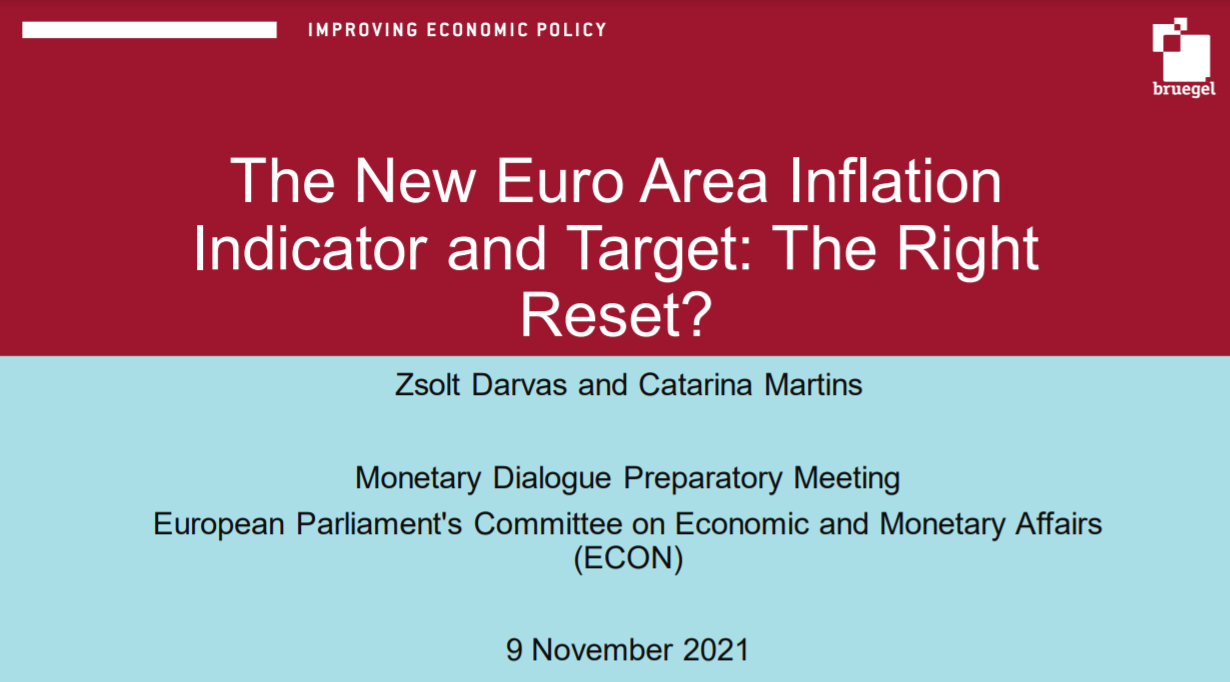Blog Post
A new European tool to deal with unjustified rising spreads
The European Central Bank needs a new tool to prevent the current rise in spreads, triggered by monetary policy tightening, from escalating into a new euro-area crisis.
The European Central Bank announced on 9 June 2022 that it plans to increase interest rates in July and September to tame inflation. The expectation of rate increases has already resulted in a significant increase in spreads between euro-area countries. While some yield divergence is justified by fundamental economic differences (such as higher debt, weaker institutions or greater risk of political instability), the risk is that spreads increase beyond what is justified and spiral out of control. This is dangerous for the countries in question and ultimately for the euro itself.
Debt sustainability is unlikely to be jeopardised in the immediate future. The difference between interest paid on the stock of debt and nominal growth of output (r-g) is expected to remain favourable in the next few years. This means that debt-to-GDP ratios should fall. Servicing costs can be expected to increase only very gradually as policy rates increase, in part thanks to the generalised lengthening of the maturity of sovereign debts in the last decade. However, this still leaves a significant risk of self-fulfilling crises in euro-area sovereign debt markets.
It is thus the right time for a new ECB tool to prevent countries from experiencing such crises. ECB President Christine Lagarde mentioned in March and in subsequent press conferences the possible introduction of such an instrument. On 14 June, ECB Executive Board member Isabel Schnabel reiterated the idea. On 15 June, the ECB’s Governing Council finally announced that it will “mandate the relevant Eurosystem Committees together with the ECB services to accelerate the completion of the design of a new anti-fragmentation instrument for consideration by the Governing Council”.
However, the ECB has not yet indicated what the tool would look like in practice. We discuss how the tool could be designed and implemented, with the aim of neutralising the additional risk that monetary tightening could impose on some countries, while remaining within the bounds set by the EU Treaties.
First principles for a new anti-fragmentation instrument
A tool to deal with widening spreads at the current juncture should have three main features (as we discussed in more detail here): 1) it should be country-specific, 2) it needs to be applied only when the debt sustainability of the countries in question is validated by a process that ensures political legitimacy, and 3) it needs to be applied in conjunction with interest rate decisions in order for the whole framework to be consistent.
The tool would take the form of an asset purchase programme but should be applied only to those that face an excessive widening of their spreads. But what ‘excessive’ means is very difficult to determine in practice. ECB intervention in all cases in which yields increase significantly, without knowing whether these increases are justified by fundamentals, would put an end to market discipline. This would be difficult to reconcile with the EU Treaty and its interpretation by the EU Court of Justice. An ex-ante condition therefore, which would be both necessary and sufficient for the ECB to justify targeted asset purchases, would be for that country’s debt to be considered sustainable, and for that country to commit to maintaining sound policies so its debt continues to be sustainable. But should the ECB be able to decide this by itself without political approval? We would prefer the ECB to rely on an external risk assessment, to avoid the risk of the ECB looking politicised.
One recent proposal was that the ECB should create a new ‘Outright Monetary Transaction (OMT) for external shocks’ (such as the war in Ukraine) that would not be conditional on European Stability Mechanism approval but would be implemented via another institutional setup. OMT is indeed the scheme that comes closest to being country-specific while having the necessary political backing, provided by the ESM’s involvement. But the OMT was designed to deal with genuine debt crises, whereas now a tool is needed to accompany interest rate hikes. Meanwhile, the involvement of the ESM in providing political backing makes it too slow and subject to political compromises that might not be in the best interest of the country in distress or of the whole euro area. The tool needed now should be applied, or at the very least decided, in conjunction with interest rates hikes in a consistent framework that aims to neutralise the risk of excessive increases in spreads in real time. Moreover, it should be designed to allow the whole risk-free yield curve to move upwards in sync with short-term policy rates, in order to tighten monetary policy effectively, while country spreads are kept in check.
An external technical analysis should confirm the sustainability of a country’s debt, which would then be approved politically. This would enable the ECB to then consider a targeted asset purchase programme that neutralises the excess increase in spreads in the wake of interest rate increases (or when QE stops), without fearing that it oversteps its mandate or makes political choices.
A widely-acceptable political evaluation of a country’s debt sustainability would also allow the ECB to reform its collateral framework. If an external process can validate debt sustainability, the ECB could move away from relying on private ratings to decide about the eligibility or the haircuts applied to sovereign bonds, and instead rely on this external assessment.
The ECB’s independence would not be in danger as it would then be the sole decision-maker on whether this new anti-fragmentation tool should be used or not, but it would decide knowing that there is an independent evaluation of the solvency of the country. The ECB would then not be accused of carrying out monetary financing and would not breach limits set by the EU Treaty.
This new tool would be a complement to OMT, not a substitute. OMT would still remain at the ECB’s disposal when there are clear risks to debt sustainability that require ESM conditionality, but it is not a tool to solve financial fragmentation when solvency is not an issue.
How can this tool be implemented?
A number of issues would need to be resolved to use such a tool in practice.
As mentioned, one of the main challenges is to measure solvency risks and identify what constitutes an ‘excessive’ increase in the spreads. This is of course the most difficult question. Central banks have previously found themselves in a position of needing to tame markets in order to avoid unjustified increase in spreads. The “whatever it takes” speech of ECB President Draghi in July 2012 and the decision to implement the pandemic emergency purchase programme (PEPP) at the start of the COVID-19 crisis in March 2020 are examples of the ECB knowing that decisive action was needed to prevent unnecessary turbulence. In both these cases, the ECB considered that the euro area was vulnerable to self-fulfilling crises in its sovereign debt markets, and decided to act decisively by announcing the creation of (country-specific) asset purchase programmes: OMT in 2012 and PEPP in 2020. In our proposal, the ECB would need to operate at country level as well, and infer precisely at which level the spread is running away from fundamentals – ie exceeding necessary market discipline – thus impairing the transmission of monetary policy, while debt is deemed sustainable.
In practice, while interest-rate and asset-purchase decisions need to be taken together, the examination of debt sustainability does not need to happen at the same time. The fiscal monitoring by the European Commission, and the Macroeconomic Imbalances Procedure, which happen annually, could serve as a system of checks and balances, in particular if followed by a formal political endorsement from a legitimate body. An annual process of this sort does not preclude the possibility of intervention in the event of an abrupt change in circumstances.
One important caveat is that it is difficult to imagine the Commission ever announcing that a county’s debt is unsustainable, not least because such an announcement would be self-fulfilling (especially if market participants anticipate that this is a requirement for the ECB to play a backstop role). What would be useful however would be for the Commission to present forward-looking scenarios that reflect risks, and then to ask a legitimate political body to assess which of these scenarios should be considered the baseline. One of two things would then be possible.
Either the risks are considered manageable and the debt of a country is deemed sustainable by its European peers, in which case the ECB could proceed with buying assets (or accept them as collateral) without fear of overstepping its mandate. Or these risks are prohibitive and would require a major change in economic policies, in which case the country should apply for an ESM programme before the ECB can decide about buying its assets in the context of an OMT programme.
Ensuring legitimacy
Which political body should play the crucial (and demanding) assessment role? This question is difficult to answer in the context of the imperfect European governance framework.
An obvious candidate is the European Council, or effectively the Eurogroup, in which the decision would be taken by qualified majority (as is the case for Council decisions on compliance with fiscal rules, whereas ESM decisions require unanimity). Finance ministers defend first and foremost their countries’ interests. This could therefore lead to heated debates that are captured by political agendas and lead to sub-optimal outcomes. But it would still be preferable to leaving the role of imposing fiscal discipline fully to markets, which react pro-cyclically and are unaccountable, or even to letting the ECB decide by itself. As long as there is no euro-area treasury, or any other form of an executive body, the Council and the Eurogroup, despite their governance flaws, are the main political bodies most able to take this type of decision at the euro-area level.
However, if one wanted to ensure that European, rather than countries’, interests are taken into account, the European Parliament could play this role. This would not be unproblematic either, not least because European citizens are insufficiently represented.
None of these potential solutions to this difficult political-economy problem brought about by market fragmentation are simple – or even optimal. But they represent the best options currently available to deal with this real threat. The greatest risk currently is the risk of doing nothing.
Other issues to consider include what level of purchases would be necessary to return spreads to economically justified levels, and whether asset purchases for one country alone affect not only that country’s spreads but also those of others. Research by the ECB – in particular on how to model the drivers of changes in spreads – is sorely needed to understand the way such a tool should be implemented. Just as tools considered unconventional were created in extraordinary times and have since found a rightful place in the ECB’s conventional tool-box, now is the time to investigate how to deal with financial fragmentation as monetary policy tightens. This could prove pivotal for the stability of the euro.
Recommended citation:
Claeys, G. and M. Demertzis (2022) ‘A new European tool to deal with unjustified rising spreads’, Bruegel Blog, 20 June
Republishing and referencing
Bruegel considers itself a public good and takes no institutional standpoint. Anyone is free to republish and/or quote this post without prior consent. Please provide a full reference, clearly stating Bruegel and the relevant author as the source, and include a prominent hyperlink to the original post.












